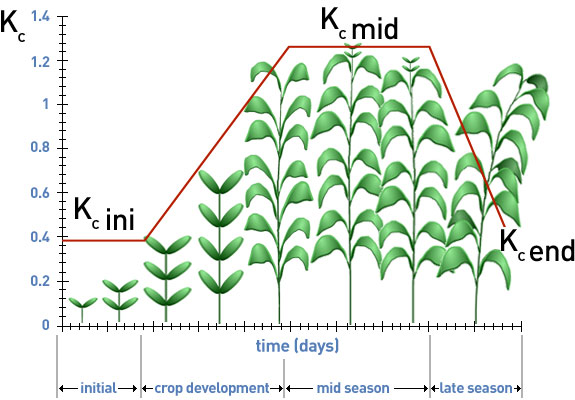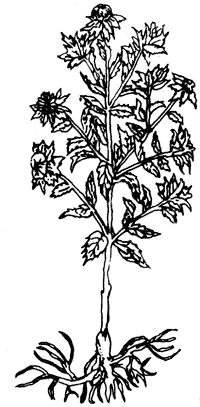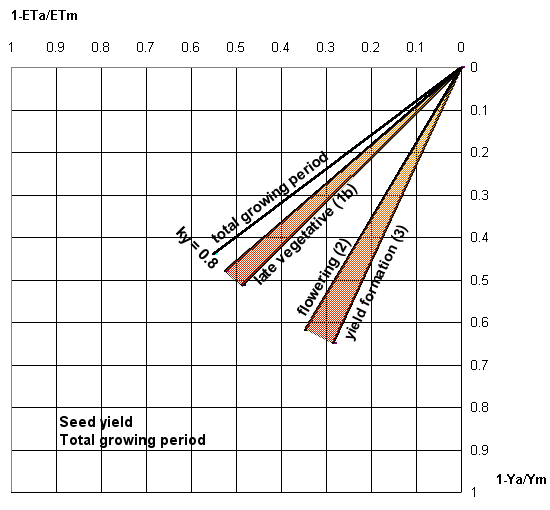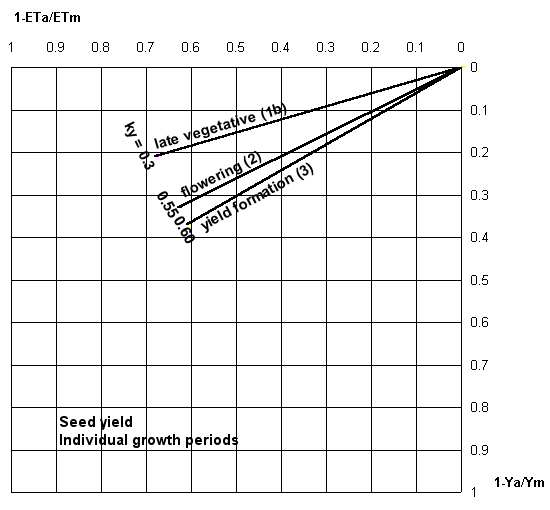Safflower
This section presents information on water relations and water management of safflower and provides links to other sources of information.
Crop Description and Climate
Crop Description and Climate
Safflower (Carthamus tinctorius) is only known in its cultivated form with centres of origin probably in the Near East. The estimated world production is about 0. 6 million tons of seed per year from about 0.85 million ha.(FAOSTAT, 2001). The flowers from the spiny cultivars are grown for oil, while some spineless cultivars are used for dye production.
Safflower is not suited to lowland, humid tropics. Large scale commercial cropping is practised in USA and USSR between 30° and 45°N and in Australia between 15° and 35°S. Emerging plants need cool temperatures for root growth and rosette development (mean daily temperature 15 to 20°C) and higher temperatures during stem growth, flowering and yield formation periods (20 to 30°C). There is no germination below 2°C. At 5°C germination takes 16 days and at 16°C, 4 days. The seedling is frost-resistant up to -7°C but after this stage frost below -2°C kills the plant. The crop seems to be sensitive to daylength but the effect is difficult to quantify. The length of the growing period for an autumn-planted crop varies from 200 to 230 days; when planted in spring, 120 to 160 days.
Safflower requires a fertile, fairly deep and well-drained soil. For irrigated production a medium-textured soil is preferable. Shallow soils seldom produce high yields. On suitable soils roots go down to 3.5m; dense subsoils retard root growth. The crop is well adapted to the presence of a water table at a depth of up to 1 m. Under irrigation, the fertilizer requirements are 60 to 110 kg/ha N, 15 to 30 kg/ha P and 25 to 40 kg/ha K. Though there is a rather wide tolerance to H, high yields are obtained on soils with a neutral reaction; when pH is lower than liming may be advisable.
The crop is moderately tolerant to salinity, ranking just below cotton. Yield decrease due to soil salinity is 0% at ECe 5.3, 10% at 6.2, 25% at 7.6, 50% at 9.9 and 100°/ at ECe 14.5 mmhos/cm. During germination the seedlings are about half as tolerant, which is relatively high compared to other crops.
Row spacing varies from 0.5 to 0.8 m, with 15 to 35 plants per metre of row. Seed rate for broadcast sowing of the irrigated crop is 40 to 50 kg/ha; for row crops, seed rate is 20 to 25 kg/ha.
The graph below depicts the crop stages of safflower, and the table summarises the main crop coefficients used for water management.

Stages of Development | Plant date | Region | |||||
|---|---|---|---|---|---|---|---|
Crop characteristic | Initial | Crop | Mid- season | Late | Total | ||
Stage length, days | 20 | 35 | 45 | 25 | 125 | Apr | California, USA |
Depletion Coefficient, p | - | - | - | - | 0.6 |
| |
Root Depth, m | - | - | - | - | 1.0 |
| |
Crop Coefficient, Kc | 0.35 | >> | 1.0-1.151 | 0.25 | - |
| |
Yield Response | 0.3 | 0.55 | 0.6 | - | 0.8 | ||
Water Requirements
Water Requirements
The reputation of safflower as a drought resistant crop is mainly based on its ability to withdraw water from a depth of up to 3.5 m. It has proved, however, to have well-defined water requirements. For optimum crop yields, the total water requirements vary between 600 and 1200 mm depending on 'climate and length of total growing period. The crop water requirements (ETm) as related to reference evapotranspiration are given by the crop coefficients (kc): initial stage 0.3-0.4 (20 to 35 days); crop development stage 0. 7-0.8 (35 to 75 days); mid-season stage 1.05-1.2 (45 to 65 days); late season stage 0.65-0.7 (25 to 40 days) and at harvest 0.21-0.25.
Water Supply And Crop Yield
Water Supply And Crop Yield
Following figure presents Safflower, spiny cultivar during flowering period (Weiss, 1971)

The relationships between relative yield decrease (1 - Ya/Ym) and relative evapotranspiration deficit for the total growing period of safflower are shown in the figure below.

This figure shows the relationships between relative yield decrease (1 - Ya/Ym) and relative evapotranspiration deficit for the individual growth periods.

Safflower is particularly susceptible to excess water because of its reaction to diseases under wet conditions. Excessive humidity, especially fog, induces head rot; excessive soil water causes root rot; excessive rain at flowering (period 2) adversely affects pollination and prevents complete seed filling which may not be noticeable in the field; excessive rainfall after the crop reaches maturity leads to seed germination in the head.
The relationships between relative yield reduction and relative evapotranspiration deficit based on interpreted information are shown in Figure 37. Water deficits during the early vegetative period (1a) and the late vegetative period (1b) cause a reduction in growth and prolong the total growing period. Safflower tolerates periods of water deficit but for maximum production flowering and yield formation (3) are the most sensitive periods to water deficit. Under conditions of limited water supply, overall production is increased by extending the area and partially meeting the crop water requirements rather than by meeting the full crop water requirements over a limited area.
For a 155-day total growing period the length of the different growth periods is:
Crop stage | Days | |
0 | Establishment | 4-10 |
1a | Early vegetative (rosette development) | 25 |
1b | Late vegetative (elongation and branching) | 60 |
2 | Flowering | 30 |
3 | Yield formation (seed filling) | 25 |
4 | ripening | 10 |
Total | 150-160 | |
Water Uptake
Water Uptake
The rooting system of safflower is extensive and in deep soils roots may extend to 3.5m, but normally 100 percent of the water uptake of a full grown crop takes place from the first 1 to 2m (D = 1.0-2.0m). Under conditions when maximum evapotranspiration is 5 to 6mm/day, water uptake starts to be reduced when 60 per-cent of the total available soil water has been depleted.
Irrigation Scheduling
Irrigation Scheduling
Irrigation scheduling should be aimed at minimizing excess soil water, particularly in relation to the sensitivity of the crop to root rot. A deep pre-planting irrigation is therefore very effective, followed by infrequent but heavy applications of water. Due to the deep rooting already during the early vegetative period (1a), the soil depth must be considered when deciding on the desirability of heavy watering.
In deep soils with high water holding capacity, usually two irrigation applications are sufficient, i. e. one before planting and one during flowering. However, a frequent mistake is a too early second application. On soils of lighter texture or when evapotranspiration demands are high, three-or more applications may be necessary.
Irrigation Methods
Irrigation Methods
The crop is most commonly grown under surface irrigation, by the border method, allowing heavy irrigation applications. Also subirrigation is used and gives high yields.
Yield
Yield
Under rainfed conditions good average yields vary from 2 to 3 ton/ha unshelled nuts under a high Under rainfed conditions yields depend on initial soil water storage and on the rainfall during the growing season. Good rainfed yields are in the range of 1 to 2.5ton/ha; under irrigation in the range of 2 to 4 ton/ha. The water utilization efficiency for harvested yield (Ey) for seed containing 8 to 10 percent moisture varies between 0.2 and 0.5 kg/m3.
The oil content varies from 20 to 40 percent depending on the variety and some recently developed Indian varieties may yield up to 50 percent oil. These new varieties are early maturing, more cold resistant and spineless, but are more susceptible to root rot and rust.
Time of picking depends on the use of the harvested product. Varieties with fruits of a high flesh/pit ratio and uniform shape are used for table olive production. In the northern hemisphere, green table olives are harvested from mid-September onward with end of harvest being determined when the fruit colour changes to green-yellow. Black table olives are harvested in December. Olives for oil are harvested from mid-December until March with oil content independent of the time of harvest.
Maximum oil content and weight are reached six to eight months after flowering. Olive fruits can be harvested long before they fall naturally.
Yields vary from year to year and from tree to tree. Good commercial yields under irrigation are 50 to 65 kg/tree of fruit with a possible maximum of 100 kg/tree of fruit. Oil content of the fresh fruit ranges from 20 to 25 percent. The water utilization efficiency for harvested yield (Ey) for fresh olives containing about 30 percent moisture is 1.5 to 2.0 kg/m3.
